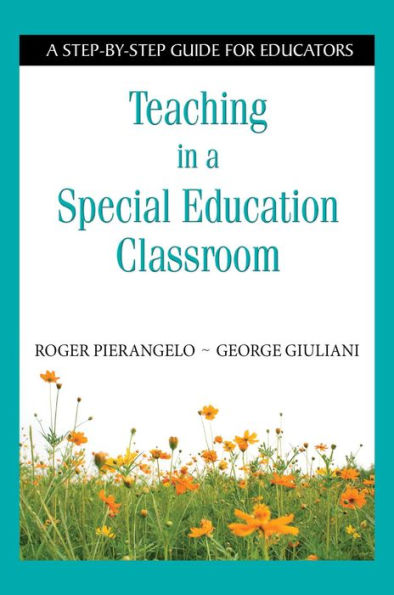
Teaching in a Special Education Classroom: A Step-by-Step Guide for Educators
120
Teaching in a Special Education Classroom: A Step-by-Step Guide for Educators
120eBook
Related collections and offers
Overview
Experts Roger Pierangelo and George Giuliani review all aspects of special education teaching, from how to get to know your students before school starts to writing end-of-the-year reports. Aligned with the reauthorization of IDEA 2004, this guidebook provides practical guidelines for appropriate classroom design, includes a complete glossary, and examines critical issues such as Gathering information on students' educational and medical backgrounds and Individual Educational Programs (IEPs), Meeting with parents, aides, mainstream teachers, and service providers, Addressing and evaluating factors that affect learners' performance and adapting the curriculum, Managing a classroom of students with specific disabilities and applying instructional interventions, Understanding grading options.
Teaching in a Special Education Classroom offers straightforward advice to make the school year more productive for you and your students.

Product Details
| ISBN-13: | 9781634507196 |
|---|---|
| Publisher: | Skyhorse |
| Publication date: | 03/20/2018 |
| Sold by: | SIMON & SCHUSTER |
| Format: | eBook |
| Pages: | 120 |
| File size: | 796 KB |
About the Author
Table of Contents
Preface xi
Acknowledgments xiii
About the Authors xv
What to Do Before the School Term Begins: Getting to Know Your Students 1
Designing and Setting Up Your Classroom 11
Designing the Special Education Classroom 11
Station-Oriented Model 11
Child-Oriented Model 13
Teacher-Oriented Model 13
Setting Up Your Inclusion Classroom 13
Helpful Sites for Information on Setting Up a Classroom 16
Evaluating Existing Materials 16
Meeting With Parents and Staff Members 19
Communicating With Parents 19
Learn How to Conduct Effective Parent Conferences 19
Communicating With Parents for Primary Inclusion Teachers 22
Communicating With Parents for Secondary Inclusion Teachers 24
Meeting With Your Assistant Teacher or Aide Before School Begins (Special Education Class) 25
Meet With Your Inclusion Team Teacher (Inclusion Class) 27
Communicating With Related-Service Providers (All Settings) 29
Communicating With Your Student's Regular Education Teachers (Resource Room Teachers) 30
Communicating With the Mainstreaming Team and Classroom Teachers(Self-Contained Class) 32
Factors Affecting Curriculum Performance for Students With Special Needs 35
Factors Affecting Curriculum 36
Academic Factors 36
Environmental Factors 37
Intellectual Factors 38
Language Factors 38
Medical Factors 39
Perceptual Factors 40
Psychological Factors 40
Social Factors 42
Adapting the Curriculum for Students With Special Needs 43
What Are Curriculum Adaptations? 43
Examples of Curriculum Adaptation 44
Assessing Student Progress 45
Ways to Adapt the Curriculum 46
Strategies for Adapting Tests and Quizzes 49
Adapting Response Mode 51
Classroom Management of Children With Specific Disabilities 53
Students With Learning Disabilities 54
Adjust the Means of Presentation and Evaluation 54
Students With Mental Retardation 56
Techniques for Teaching Children With Mental Retardation 56
Vocational and Career Skill Development 58
Students With Emotional Disabilities 59
Helping the Student Complete Classwork Assignments 59
Students With Attention Deficit/Hyperactivity Disorder 59
Organization 59
Academic Skills 60
Apply Instructional Interventions for Specific Behaviors Exhibited in the Classroom by Students With Emotional and/or Behavioral Disorders 61
Instructional Interventions for Active Noncompliance 61
Examples of Behavior 61
Desired Alternative Behavior(s) 62
General Instructional Strategies That Might Be Useful in Teaching the Desired Behavior(s) 62
Instructional Interventions for Attendance Problems 63
Examples of Behavior 63
Desired Alternative Behavior(s) 63
General Instructional Strategies That Might Be Useful in Teaching the Desired Behavior(s) 63
Instructional Interventions for Difficulty With Transitions 65
Examples of Behavior 65
Desired Alternative Behavior(s) 65
General Instructional Strategies That Might Be Useful in Teaching the Desired Behavior(s) 65
Instructional Interventions for Disrespect to Teachers 66
Examples of Behavior 66
Desired Alternative Behavior(s) 66
General Instructional Strategies That Might Be Useful in Teaching the Desired Behavior(s) 67
Instructional Interventions for Classroom Disruption 67
Examples of Behavior 67
Desired Alternative Behavior(s) 68
General Instructional Strategies That Might Be Useful in Teaching the Desired Behavior(s) 68
Instructional Interventions for Failure to Accept Responsibility for Own Behavior and/or Consequences for Misbehavior 69
Examples of Behavior 69
Desired Alternative Behavior(s) 69
General Instructional Strategies That Might Be Useful in Teaching the Desired Behavior(s) 69
Instructional Interventions for Interpersonal Relationships With Peers 70
Examples of Behavior 70
Desired Alternative Behavior(s) 70
General Instructional Strategies That Might Be Useful in Teaching the Desired Behavior(s) 70
Instructional Interventions for Out-of-Control Behaviors 71
Examples of Behavior 71
Desired Alternative Behavior(s) 71
General Instructional Strategies That Might Be Useful in Teaching the Desired Behavior(s) 71
Instructional Interventions for Passive Resistance 71
Examples of Behavior 71
Desired Alternative Behavior(s) 72
General Instructional Strategies That Might Be Useful in Teaching the Desired Behavior(s) 72
Instructional Interventions for Not Respecting Property or Personal Space of Others 73
Examples of Behavior 73
Desired Alternative Behavior(s) 73
General Instructional Strategies That Might Be Useful in Teaching the Desired Behavior(s) 73
Instructional Interventions for Verbal Aggression 74
Examples of Behavior 74
Desired Alternative Behavior(s) 74
General Instructional Strategies That Might Be Useful in Teaching the Desired Behavior(s) 74
Instructional Interventions for Verbal Outbursts 75
Examples of Behavior 75
Desired Alternative Behavior(s) 75
General Instructional Strategies That Might Be Useful in Teaching the Desired Behavior(s) 75
Understanding Grading Options for Students With Special Needs 77
Grading Options 77
Reporting to Parents 79
Developing Cooperative Educational Plans for Your Students 85
End-of-School-Year Responsibilities 89
Triennial Evaluation Reports 89
Annual Review Meetings 90
Declassification Considerations and Procedures 92
Extended School Year (ESY) Services 93
End-of-School-Year Reports 95
Final Summary 96
Glossary 97
References 99
Index 101
